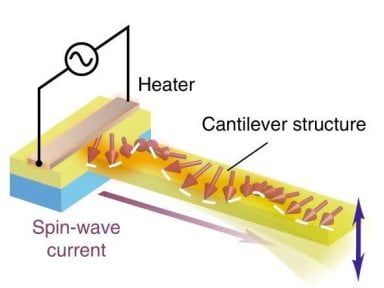When the spins of phosphorus atoms in silicon are energized with microwaves, a spin quantum echo signal can be detected after a certain time.
Fundamental particles can have an angular moment that points in a certain direction – a kind of “spin”, rotation or, as is more commonly known, a spin.
And the spin of a particle can be manipulated by a magnetic field. This principle is the basic idea behind magnetic resonance imaging used in hospitals, spintronic components and various types of qubits used in quantum computing.
One of the great difficulties in all these applications is that a certain spin – or, more generally, a quantum state of a particle – is very fragile, being lost by minimal noise or interference.
An international research team has now discovered a surprising effect that is particularly suitable for dealing with this noise and processing quantum information in a robust way: the spins of phosphorus atoms inserted in a silicon wafer produce an echo. And just like sonic echoes, the spin’s echo is repeated in a series that takes a long time to fade.
The difference with the sound echo is that here the thing is not done in screaming, but with pulses of energy. When an original spin is reinforced with microwave pulses, it produces a spin echo that can be detected after a certain time, with the signal from the injected pulse being reissued as a quantum echo.
This means that the data stored in the particle becomes much more robust – if the data is lost, it will still be stamped on the echoes – decreasing the error rate and improving the efficiency of the system.
What is Quantum echo?
Quantum echoes are not exactly a novelty, but the energy pulses that generate them reach a multiplicity of atoms, which respond in different times, which in practice produces more of a mess of moving spins and multiple echoes than a stable situation.
What Stefan Weichselbaumer and his colleagues at the University of Vienna have discovered is that it is possible to reverse this apparent chaos with the help of another electromagnetic pulse – a suitable pulse can reverse the spin rotation, causing everyone to coordinate again.

“You can imagine it’s a bit like running a marathon,” illustrated Professor Stefan Rotter. “At the start signal, all the runners are still together. As some runners are faster than others, the group of runners gets bigger and bigger over time. However, if all runners received the signal to return to the start, all runners would return to the start more or less at the same time, although faster runners have to cover a greater distance back than slower runners”.
The quantum echo represents exactly that – an echo of when all the spins were initially aligned. “What’s remarkable is that we weren’t able to measure just a single echo, but a series of several echoes,” said Hans Hubl, a team member.
Quantum information and medical tests
The team was also able to identify how it is possible that this quantum echo can make all the runners return to the starting point as if by magic. What occurs is a strong coupling between the spins and the photons of the microwave resonator used to energize them. “This coupling is the essence of our experiment: you can store information in the spins and, with the help of the microwave photons in the resonator, you can modify or read them,” Hubl explained.
The physics of the spin echo is of great importance for technical applications, and can improve magnetic resonance imaging examinations, for example. But the team intends to focus its efforts on the new possibilities offered by multiple echo, such as the processing of quantum information. “Of course, several echoes in spin sets strongly coupled to the photons of a resonator are a new and exciting tool. It will not only find useful applications in quantum information technology, but also in spin-based spectroscopy methods,” said Professor Rudolf Gross.





